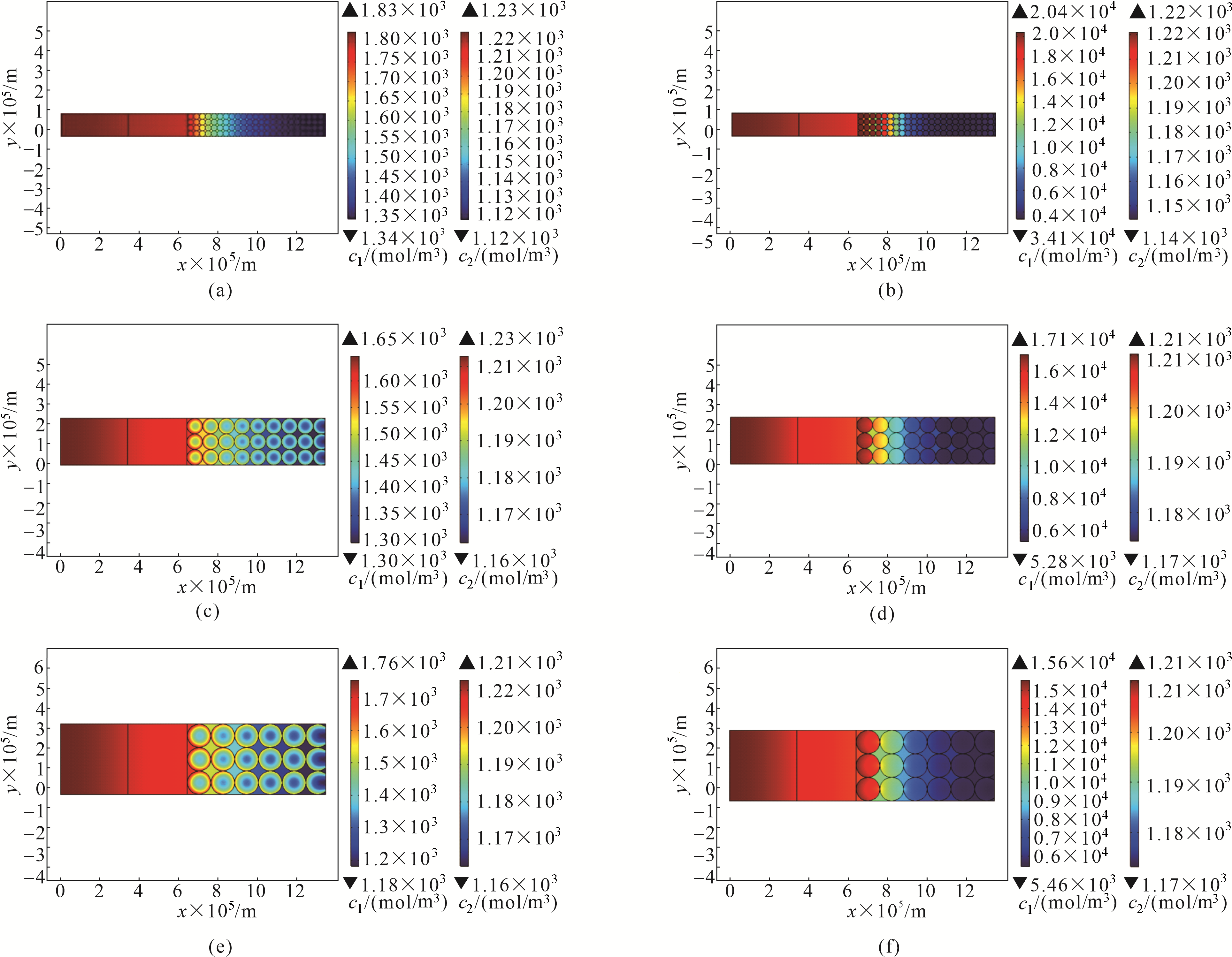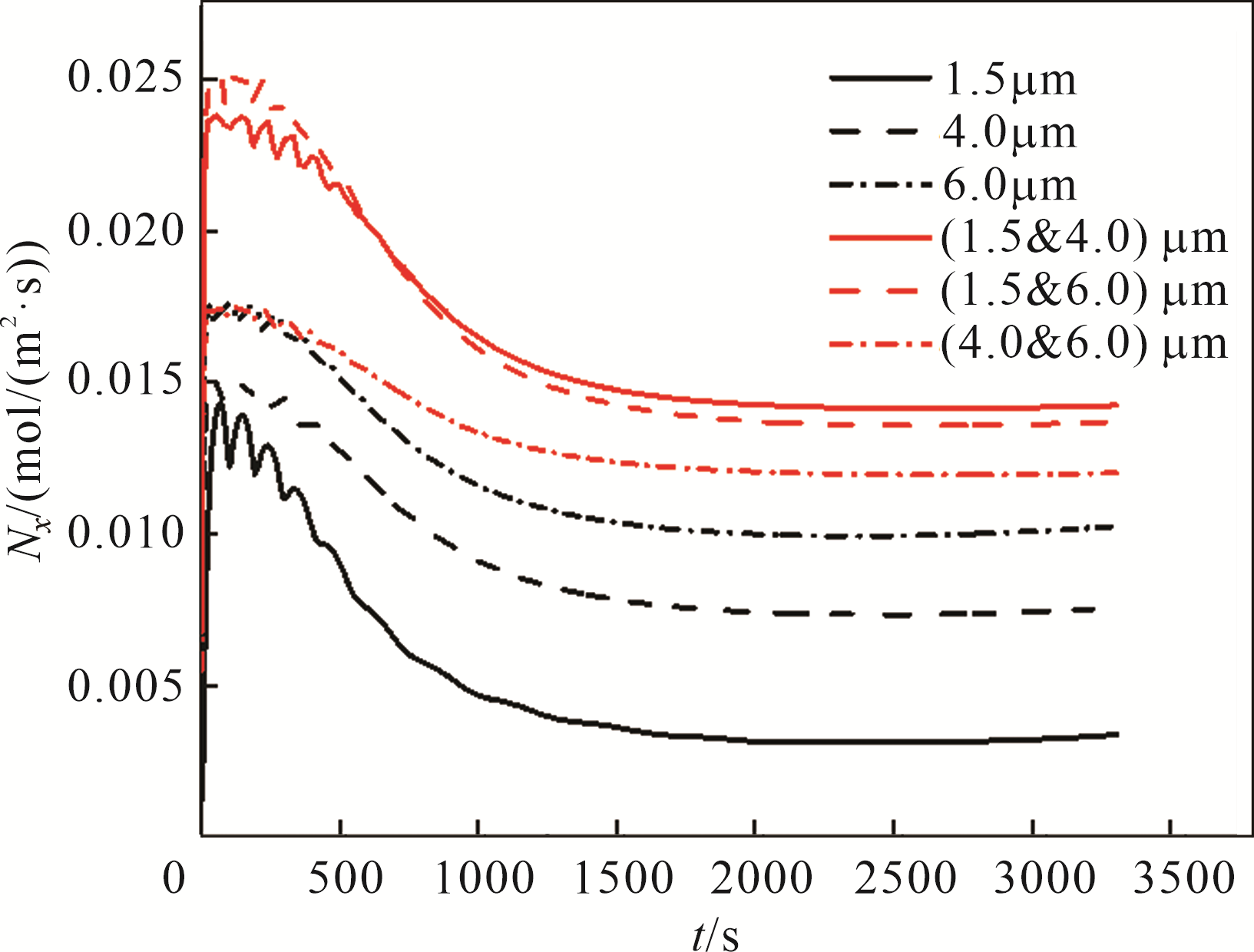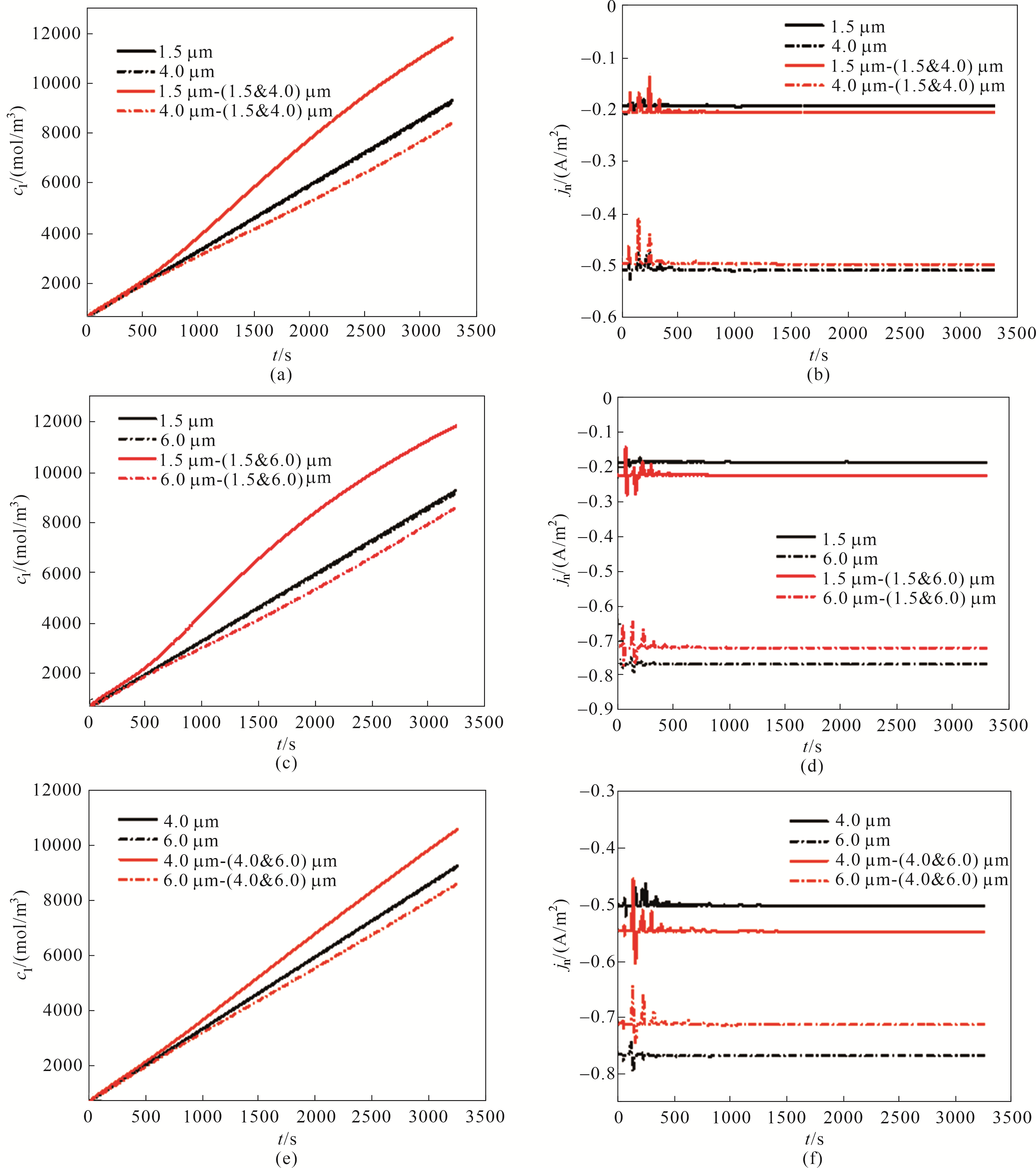化工学报 ›› 2021, Vol. 72 ›› Issue (2): 1078-1088.DOI: 10.11949/0438-1157.20201095
收稿日期:2020-08-03
修回日期:2020-09-11
出版日期:2021-02-05
发布日期:2021-02-05
通讯作者:
周静红
作者简介:陈怡沁(1995—),女,硕士研究生,基金资助:
CHEN Yiqin( ),XU Yu,ZHOU Jinghong(
),XU Yu,ZHOU Jinghong( ),SUI Zhijun,ZHOU Xinggui
),SUI Zhijun,ZHOU Xinggui
Received:2020-08-03
Revised:2020-09-11
Online:2021-02-05
Published:2021-02-05
Contact:
ZHOU Jinghong
摘要:
锂离子电池是目前应用较广的储能设备,具有能量密度高、使用寿命长等特点。随着锂离子电池正极材料实际能量密度接近理论值,电池组装工艺参数的优化成了提升其性能的重要途径,其中电极颗粒粒径及分布是十分重要的参数。因此,本文针对石墨-LiFePO4体系锂离子电池,利用异构模型构建单粒径和双粒径电极的几何结构,再结合Newman模型模拟其放电过程,定量研究了正极材料粒径分布对锂离子电池性能的影响,探究了存在粒径分布的电极中不同粒径的颗粒在充放电过程的作用机制。模拟结果表明,粒径的减小可以减小固相扩散系数对电池性能的影响,但会增加液相扩散阻力;而粒径的分布可以促进锂离子在电解液中的扩散,提高小粒径颗粒的锂嵌入量,但会引起极化增大,导致大颗粒的锂嵌入量降低。粒径分布宽度越大,总体粒度越大,锂离子电池的能量密度越小。选择合适的粒径分布宽度,适当减小总体粒度的大小,能有效提升电极的能量密度。研究结果对于锂离子电池电极活性材料颗粒粒径分布的选择提供了有益的基础知识和指导。
中图分类号:
陈怡沁, 许于, 周静红, 隋志军, 周兴贵. 锂离子电池异构建模及内部传质机理探究:粒径分布的影响[J]. 化工学报, 2021, 72(2): 1078-1088.
CHEN Yiqin, XU Yu, ZHOU Jinghong, SUI Zhijun, ZHOU Xinggui. Heterogeneous modeling and internal mass transfer mechanism of lithium-ion batteries: effect of particle size distribution[J]. CIESC Journal, 2021, 72(2): 1078-1088.

图1 单粒径锂离子电池几何结构示意图(a);双粒径锂离子电池几何结构示意图(b)
Fig.1 Geometry schematic of lithium ion battery with positive electrode of single-sized particles (a); Geometry schematic of lithium ion battery with positive electrode of bimodel-sized particles (b)

图5 单粒径锂离子电池的电解液内锂离子浓度与颗粒内固态锂浓度分布随时间的变化(a) Rp = 1.5 μm,放电时间300 s;(b) Rp = 1.5 μm,放电时间3000 s;(c) Rp = 4.0 μm,放电时间300 s;(d) Rp = 4.0 μm,放电时间3000 s;(e) Rp = 6.0 μm,放电时间300 s;(f) Rp = 6.0 μm,放电时间3000 s
Fig.5 The concentration distribution of lithium ion in the electrolyte and metal lithium in active particles for lithium-ion battery with single-sized particles(a) Rp = 1.5 μm, discharge time is 300 s; (b) Rp = 1.5 μm, discharge time is 3000 s; (c) Rp = 4.0 μm, discharge time is 300 s; (d) Rp = 4.0 μm, discharge time is 3000 s; (e) Rp = 6.0 μm, discharge time is 300 s; (f) Rp = 6.0 μm, discharge time is 3000 s

图6 1 C放电条件下放电500 s时,单粒径锂离子电池正极内部锂离子通量
Fig.6 The lithium ion flux inside the positive electrode with single-sized particles when discharging for 500 s under 1 C discharge rate

图8 双粒径锂离子电池电解质溶液中锂离子与颗粒内固态锂的浓度分布随时间的变化(a) (1.5&4.0)μm,放电时间300 s;(b) (1.5&4.0)μm,放电时间3000 s; (c) (1.5&6.0)μm,放电时间300 s;(d) (1.5&6.0)μm,放电时间3000 s; (e) (4.0&6.0)μm,放电时间300 s;(f) (4.0&6.0)μm,放电时间3000 s
Fig. 8 The concentration distribution of lithium ion in the electrolyte and metal lithium in active material particles for the lithium-ion battery with bimodel-sized particles(a) (1.5&4.0) μm, discharge time is 300 s; (b) (1.5&4.0) μm, discharge time is 3000 s; (c) (1.5&6.0) μm, discharge time is 300 s; (d) (1.5&6.0) μm, discharge time is 3000 s; (e) (4.0&6.0) μm, discharge time is 300 s; (f) (4.0&6.0) μm, discharge time is 3000 s
| Rp/μm | c1/(mol/m3) | |||
|---|---|---|---|---|
| Max | Min | Δ | ||
| 单粒径 | 1.5 | 20445.0 | 3411.8 | 17033.2 |
| 4.0 | 17066.0 | 5275.8 | 11790.2 | |
| 6.0 | 15565.0 | 5454.4 | 10110.6 | |
| 双粒径 | 1.5&4.0 | 15064.0 | 6273.8 | 8790.2 |
| 1.5&6.0 | 19848.0 | 5153.1 | 14694.9 | |
| 4.0&6.0 | 14854.0 | 5519.5 | 9334.5 | |
表1 1 C条件下放电3000 s时,单粒径和双粒径锂离子电池正极内部最大/最小固态锂浓度
Table 1 The maximum and minimum concentration of the metal lithium in the positive electrode with single-sized particles and bimodel-sized particles when discharging for 500 s under 1 C discharge rate
| Rp/μm | c1/(mol/m3) | |||
|---|---|---|---|---|
| Max | Min | Δ | ||
| 单粒径 | 1.5 | 20445.0 | 3411.8 | 17033.2 |
| 4.0 | 17066.0 | 5275.8 | 11790.2 | |
| 6.0 | 15565.0 | 5454.4 | 10110.6 | |
| 双粒径 | 1.5&4.0 | 15064.0 | 6273.8 | 8790.2 |
| 1.5&6.0 | 19848.0 | 5153.1 | 14694.9 | |
| 4.0&6.0 | 14854.0 | 5519.5 | 9334.5 | |

图9 1 C 放电时,双粒径及单粒径锂离子电池正极中(x=100 μm),靠近集流体处的锂离子通量随时间的变化曲线
Fig.9 The lithium ion flux during discharge time inside the positive electrode with single-sized particles and bimodel-sized particles(x=100 μm) under 1 C discharge rate

图10 1 C 放电时,单粒径与双粒径锂离子电池正极大颗粒与小颗粒平均固态锂浓度[(a)、(c)、(e)]和表面电流密度[(b)、(d)、(f)]随放电时间变化的比较
Fig.10 The average solid lithium concentration [(a),(c),(e)] and surface current density [(b),(d),(f)] of the large and small particles in the positive electrode of the lithium ion battery with single-sized and bimodal-sized particles during the discharge time under 1 C discharge rate
| 1 | Feng X, Ouyang M, Liu X, et al. Thermal runaway mechanism of lithium ion battery for electric vehicles: a review[J]. Energy Storage Materials, 2018, 10: 246-267. |
| 2 | Zhang W J. Structure and performance of LiFePO4 cathode materials: a review[J]. Journal of Power Sources, 2011, 196(6): 2962-2970. |
| 3 | 杨杰, 王婷, 杜春雨, 等. 锂离子电池模型研究综述[J]. 储能科学与技术, 2019, 8(1): 58-64. |
| Yang J, Wang T, Du C Y, et al. Overview of the modeling of lithium-ion batteries[J]. Energy Storage Science and Technology, 2019, 8(1): 58-64. | |
| 4 | Jokar A, Rajabloo B, Désilets M, et al. Review of simplified pseudo-two-dimensional models of lithium-ion batteries[J]. Journal of Power Sources, 2016, 327: 44-55. |
| 5 | Doyle M, Fuller T F, Newman J. Modeling of galvanostatic charge and discharge of the lithium/polymer/insertion cell[J]. Journal of the Electrochemical Society, 1993, 140(6): 1526-1533. |
| 6 | Doyle M, Newman J. The use of mathematical modeling in the design of lithium/polymer battery systems[J]. Electrochimica Acta, 1995, 40(13/14): 2191-2196. |
| 7 | Yu S, Kim S, Kim T Y, et al. Transportation properties in nanosized LiFePO4 positive electrodes and their effects on the cell performance[J]. Journal of Applied Electrochemistry, 2013, 43(3): 253-262. |
| 8 | Heubner C, Schneider M, Michaelis A. Diffusion-limited C-rate: a fundamental principle quantifying the intrinsic limits of Li-ion batteries[J]. Advanced Energy Materials, 2020, 10(2): 1902523. |
| 9 | 许于, 陈怡沁, 周静红, 等. LiFePO4锂离子电池的数值模拟:正极材料颗粒粒径的影响[J]. 化工学报, 2020, 71(2): 821-830. |
| Xu Y, Chen Y Q, Zhou J H, et al. Numerical simulation of lithium-ion battery with LiFePO4 as cathode material: effect of particle size[J]. CIESC Journal, 2020, 71(2): 821-830. | |
| 10 | Chen L, Chen Z, Liu S, et al. Effects of particle size distribution on compacted density of lithium iron phosphate 18650 battery[J]. Journal of Electrochemical Energy Conversion and Storage, 2018, 15(4): 041011. |
| 11 | Zhang Y, Wang Z B, Nie M, et al. A simple method for industrialization to enhance the tap density of LiNi0.5Co0.2Mn0.3O2 cathode material for high-specific volumetric energy lithium-ion batteries[J]. RSC Advances, 2016, 6(70): 65941-65949. |
| 12 | Hong J, Wei W, He G. Optimizing the particle-size distribution and tap density of LiFePO4/C composites containing excess lithium[J]. Ionics, 2019, 25(5): 2035-2039. |
| 13 | Yu S, Chung Y, Song M S, et al. Investigation of design parameter effects on high current performance of lithium-ion cells with LiFePO4/graphite electrodes[J]. Journal of Applied Electrochemistry, 2012, 42(6): 443-453. |
| 14 | Röder F, Sonntag S, Schröder D, et al. Simulating the impact of particle size distribution on the performance of graphite electrodes in lithium-ion batteries[J]. Energy Technology, 2016, 4(12): 1588-1597. |
| 15 | Goldin G M, Colclasure A M, Wiedemann A H, et al. Three-dimensional particle-resolved models of Li-ion batteries to assist the evaluation of empirical parameters in one-dimensional models[J]. Electrochimica Acta, 2012, 64: 118-129. |
| 16 | Kikukawa H, Honkura K, Koyama M. Influence of inter-particle resistance between active materials on the discharge characteristics of the positive electrode of lithium ion batteries[J]. Electrochimica Acta, 2018, 278: 385-395. |
| 17 | Awarke A, Lauer S, Wittler M, et al. Quantifying the effects of strains on the conductivity and porosity of LiFePO4 based Li-ion composite cathodes using a multi-scale approach[J]. Computational Materials Science, 2011, 50(3): 871-879. |
| 18 | 郭孝东, 钟本和, 唐艳, 等. 一次粒径和二次粒径对LiFePO4性能的影响[J]. 高校化学工程学报, 2013, 27(5): 884-888. |
| Guo X D, Zhong B H, Tang Y, et al. The influence of primary particle size and secondary particle size on performances of LiFePO4[J]. Journal of Chemical Engineering of Chinese Universities, 2013, 27(5): 884-888. | |
| 19 | Ye Y, Shi Y, Tay A A O. Electro-thermal cycle life model for lithium iron phosphate battery[J]. Journal of Power Sources, 2012, 217: 509-518. |
| 20 | Shirazi A H N, Azadi Kakavand M R, Rabczuk T. Numerical study of composite electrode's particle size effect on the electrochemical and heat generation of a Li-ion battery[J]. Journal of Nanotechnology in Engineering and Medicine, 2015, 6(4): 041003. |
| 21 | Liu H, Strobridge F C, Borkiewicz O J, et al. Capturing metastable structures during high-rate cycling of LiFePO4 nanoparticle electrodes[J]. Science, 2014, 344(6191): 1252817. |
| 22 | Sheu S P, Yao C Y, Chen J M, et al. Influence of the LiCoO2 particle size on the performance of lithium-ion batteries[J]. Journal of Power Sources, 1997, 68: 533-535. |
| 23 | 施柳柳. 以LiFePO4为正极材料的电极制备工艺研究[D]. 上海: 华东理工大学, 2018: 20-33. |
| Shi L L. Optimization of preparation process of LiFePO4 cathode[D]. Shanghai: East China University of Science and Technology, 2018: 20-33. | |
| 24 | Li Y, Meyer S, Lim J, et al. Effects of particle size, electronic connectivity, and incoherent nanoscale domains on the sequence of lithiation in LiFePO4 porous electrodes[J]. Adv. Mater., 2015, 27(42): 6591-6597. |
| 25 | Lee K, Kum D. The impact of inhomogeneous particle size distribution on Li-ion cell performance under galvanostatic and transient loads[C]// Asia-Pacific IEEE Transportation Electrification Conference & Expo. Busan, South Korea. IEEE, 2016: 454-459. |
| [1] | 康飞, 吕伟光, 巨锋, 孙峙. 废锂离子电池放电路径与评价研究[J]. 化工学报, 2023, 74(9): 3903-3911. |
| [2] | 杨越, 张丹, 郑巨淦, 涂茂萍, 杨庆忠. NaCl水溶液喷射闪蒸-掺混蒸发的实验研究[J]. 化工学报, 2023, 74(8): 3279-3291. |
| [3] | 王志龙, 杨烨, 赵真真, 田涛, 赵桐, 崔亚辉. 搅拌时间和混合顺序对锂离子电池正极浆料分散特性的影响[J]. 化工学报, 2023, 74(7): 3127-3138. |
| [4] | 葛加丽, 管图祥, 邱新民, 吴健, 沈丽明, 暴宁钟. 垂直多孔碳包覆的FeF3正极的构筑及储锂性能研究[J]. 化工学报, 2023, 74(7): 3058-3067. |
| [5] | 陈朝光, 贾玉香, 汪锰. 以低浓度废酸驱动中和渗析脱盐的模拟与验证[J]. 化工学报, 2023, 74(6): 2486-2494. |
| [6] | 李靖, 沈聪浩, 郭大亮, 李静, 沙力争, 童欣. 木质素基碳纤维复合材料在储能元件中的应用研究进展[J]. 化工学报, 2023, 74(6): 2322-2334. |
| [7] | 肖忠良, 尹碧露, 宋刘斌, 匡尹杰, 赵亭亭, 刘成, 袁荣耀. 废旧锂离子电池回收工艺研究进展及其安全风险分析[J]. 化工学报, 2023, 74(4): 1446-1456. |
| [8] | 罗来明, 张劲, 郭志斌, 王海宁, 卢善富, 相艳. 1~5 kW高温聚合物电解质膜燃料电池堆的理论模拟与组装测试[J]. 化工学报, 2023, 74(4): 1724-1734. |
| [9] | 程伟江, 汪何琦, 高翔, 李娜, 马赛男. 锂离子电池硅基负极电解液成膜添加剂的研究进展[J]. 化工学报, 2023, 74(2): 571-584. |
| [10] | 杜江龙, 杨雯棋, 黄凯, 练成, 刘洪来. 复合相变材料/空冷复合式锂离子电池模块散热性能[J]. 化工学报, 2023, 74(2): 674-689. |
| [11] | 钟磊, 邱学青, 张文礼. 木质素衍生炭在碱金属离子电池负极中的研究进展[J]. 化工学报, 2022, 73(8): 3369-3380. |
| [12] | 胡华坤, 薛文东, 霍思达, 李勇, 蒋朋. 锂离子电池电解液SEI成膜添加剂的研究进展[J]. 化工学报, 2022, 73(4): 1436-1454. |
| [13] | 贾理男, 杜一博, 郭邦军, 张希. 基于硫化物电解质的全固态锂离子电池负极研究进展[J]. 化工学报, 2022, 73(12): 5289-5304. |
| [14] | 王朋朋, 贾洋刚, 邵霞, 程婕, 冒爱琴, 檀杰, 方道来. K+掺杂尖晶石型(Co0.2Cr0.2Fe0.2Mn0.2Ni0.2)3O4高熵氧化物负极材料制备与储锂性能研究[J]. 化工学报, 2022, 73(12): 5625-5637. |
| [15] | 杨伟, 王昱杰, 方凯斌, 邹汉波, 陈胜洲, 刘自力. Co-Mn比例调控对LiNi0.8Co0.10-y Mn0.05+y Al0.05O2材料性能影响探究[J]. 化工学报, 2022, 73(12): 5615-5624. |
| 阅读次数 | ||||||
|
全文 |
|
|||||
|
摘要 |
|
|||||
 京公网安备 11010102001995号
京公网安备 11010102001995号